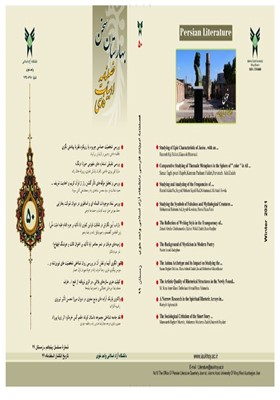The Artistic Quality of Rhetorical Structures in the Newly Found Work from Fathollah Aref
Subject Areas : Abstract ArticlesMohammad Reza Amir Khani Dehbalaee 1 , Ahmad Reza Yalameha 2
1 - PhD student, Department of Persian Language and Literature, Dehaghan Branch, Islamic Azad University, Dehaghan, Iran.
2 - ادProfessor of Persian Language and Literature, Dehaghan Branch, Islamic Azad University, Dehaghan-Iran.
Keywords: rhetoric, rhetorical criticism, Keywords: The Soleimani Shahnameh, Fathollah Aref, .exquisite,
Abstract :
Abstract The subject of this research is to study and evaluate the application of crafts of rhetorics and their criticism in the newly found work from Fathollah Aref, the poet of the 10th century and the composer of The Shahnameh in the court of Soleiman Ghanuni. One of the specifications that distinguishes one literary work from the other is the kind of its utility from its rhetoric structure which are illustrated by the writer in different ways. Regarding the epic genre of this poetry, Aref tries to create his poetry in higher or the same rank of the Shahnameh of Ferdowsi. In the discussion of rhetorics, he sometimes succeeds and the other times fails. Aref's most significant craft in this work is the sensitive expression in the description of the scenes and the choice of similarity in a different atmosphere in a distich. Aref, by posing ironic expressions and in an unexpected manner , unveils his praised one (criticizes him) . Expression together with authority, and questioning in the excellency of the abstract of the book are of his outstanding and successful crafts.
فهرست منابع و مآخذ
۱- قرآن کریم.
۲- اصفهانی، هاتف، (۱۳۹۴)، دیوان، تصحیح وحید دستگردی، تهران: نگاه
۳- انوشه، حسن، (۱۳۵۷)، دانشنامۀ ادب فارسی، ادب فارسی در آناتولی و بالکان، جلد ششم، وزارت فرهنگ و ارشاد اسلامی.
۴- تجلیل، جلیل، (۱۳۸۵)، معانی و بیان، تهران: نشر مرکزی دانشگاهی.
۵- جاحظ، عمرو، (1351 ق/ 1932م)، البیان و التبیین، به کوشش حسن سندوبی، قاهره.
۶- رضوانی، علی اصغر، (۱۳۹۰)، استمداد از اولیاء، تهران: مشعر، چاپ اوّل.
۷- ریاحی، محمد امین، (۱۳۶۹)، زبان و ادب فارسی درقلمرو عثمانی، تهران: پاژنگ.
۸- شفیعی کدکنی، محمدرضا، (۱۳۸۵)، صورخیال در شعر فارسی، تهران: آگاه.
۹- شیرازی، احمد امین، (۱۳۷۵)، آیین بلاغت، ج۲، تهران: نشر اسلامی.
۱۰- صائب تبریزی، محمدعلی، (۱۳۸۳)، غزلیّات، به کوشش محمّد قهرمان، تهران: علمی و فرهنگی.
۱۱- عارف، فتحالله، (قرن دهم ق)، شهنامۀ سلیمانی، (نسخه خطّی)، آناتولی.
۱۲- عطّار، محمّد بن ابراهیم، (۱۳۸۴)، منطق الطّیر، تصحیح محمّدرضا شفیعی کدکنی، تهران: سخن.
۱۳- فتوحی، محمود، (۱۳۸۵)، بلاغت تصویر، تهران: سخن، چاپ دوّم.
۱۴- فردوسی، ابوالقاسم، (۱۳۸۹)، شاهنامه، به اهتمام توفیق سبحانی، تهران: روزنه، چاپ اوّل.
۱۵- فشارکی، محمّد، (۱۳۸۸)، «علم بیان»، پژوهشنامۀ زبان و ادبیّات فارسی، شمارۀ ۲، صص ۱-۱۰.
۱۶- محبّتی، مهدی، (۱۳۸۰)، بدیع نو، تهران: سخن.
۱۷- ملّاح، حسینعلی، (۱۳۶۷)، پیوند شعر و موسیقی، تهران: فضا.
۱۸- منوچهری، ابوالنجم احمد، (۱۳۷۰)، دیوان، به صحیح محمّد دبیر سیاقی، تهران: زوّار.
۱۹- میرحیدر، حسین، (۱۲۹۸)، معارف گیاهی، ج۲، تهران: دفتر نشر فرهنگ اسلامی.
۲۰- همایی، جلالالدّین، (۱۳۶۱)، فنون بلاغت و صناعات ادبی، تهران: توس.
_||_

